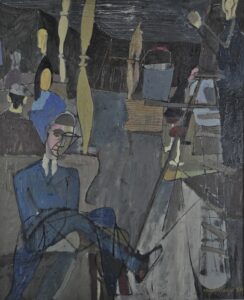The era directly following World War II was one of revitalization and invention, a sort of cultural and artistic renaissance where people tried to move past the trauma of war by emphasizing family, community, and prosperity. This was the birth of the “modern” era, and its naive idealism and unbridled invention put a stamp on our history, providing a fascinating look into the human psyche.
Heart of the House: Art & the West Coast Modern Home, at The Art Gallery of Greater Victoria (AGGV), highlights art and objects—such as paintings, sculptures, and furniture—associated with West Coast modernist architecture from the 1950s and 1960s. AGGV curator of historical and Canadian art Steven McNeil believes that examining past culture has a necessary impact on current culture, and that parallels can be found that resonate with people.

“I think that you’ve really got to look to the past in order to understand where you are today, and where you’re going,” he says. “Especially with a mid-century topic, I think there’s a lot of resonance with present-day life. There’s a real sort of spirit of optimism about BC in the mid century that I think really appeals to people today.”
McNeil says that following the war, people began to reject the architecture and lifestyle of the pre-war era and move toward a more intimate way of living.
“When you looked at more old-fashioned Victorian and Edwardian houses, they were often built with not a lot of technology, and the idea that there would be staff in the house to help run it,” says McNeil. “More modern houses were really built in a way that they had all the modern conveniences and appliances, and the more open-concept living, with the idea that it would be just the family, and doing things much more casually on their own. There was a real utopianism about that period.”
Here in BC, the architectural design reflected and supported the local ecosystem and created a very recognizable style as well as a cultural departure from the more formal lifestyle that preceded it.
“People were really looking to design homes specifically for the west coast climate,” says McNeil. “A lot of the houses had huge glass windows; there’s a muted transition between indoor and outdoor spaces, with open terraces and views into the garden. There was a real emphasis on using wood and stone and building materials that could be found locally, and so would blend in better with the natural environment, and I think that there was also a real focus on a more casual way of living.”
This period marked the genesis of suburbia, where the white picket fence and nuclear family became the hallmark of success and happiness. People yearned for a more optimistic and idealized lifestyle, however unrealistic it may be.
“There was a big drive to expand cities and build suburbs as well, where everyone wanted their back yard, and their carport or their garage to park their car, and a private garden space rather than living in more dense urban spaces,” says McNeil. “Looking back on it now, it can seem kind of antiquated and quaint, and I think that’s part of the attraction of the period.”
McNeil thinks that we’ve lost that connection to our natural surroundings and the celebration of designing and building a house that really fits in seamlessly with the landscape. Looking back on that bygone epoch is important, he says, because we gain perspective and a sense of identity.
“There were really talented artists and designers [in BC] making really fantastic works of art, amazing houses, and designing furniture,” he says. “I’d like people to appreciate what was happening in a local context, and feel proud of that. It helps people understand their community, and then feel a sense of pride and identity about the city and the province, in a bigger way.”
Heart of the House
Until Sunday, May 14
Art Gallery of Greater Victoria
aggv.ca
